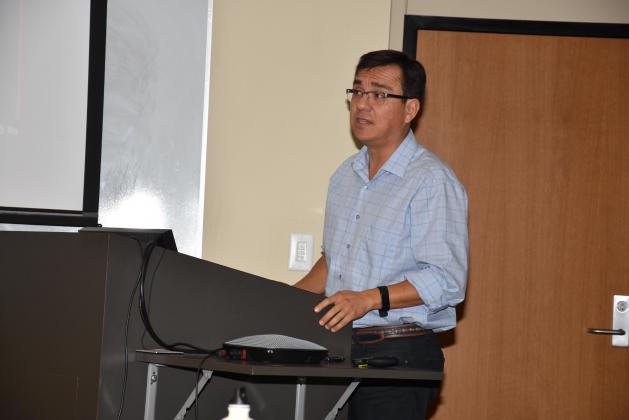
By Johnny Morgan, jmorgan@agcenter.lsu.edu
BATON ROUGE – Researchers from the LSU AgCenter and several other agencies met Dec. 16 for the second annual Roseau Cane Research Summit.
The group is collaborating to investigate the decline in health of roseau cane, or phragmites, a vital marsh grass in the lower Mississippi River Delta.
AgCenter entomologist Rodrigo Diaz is leading the group of federal and state researchers who are looking at the possible cause of the die-offs.
“We’re looking at a number of possible causes, but there’s no way to be sure until we put all the pieces together,” he said.
Diaz and the scientists began their study of the die-offs in 2016, when they were first discovered.
Jim Cronin, George C. Kent Professor in the LSU Department of Biological Sciences, suspects multiple stressors could be affecting roseau cane health. One thing he is studying is soil chemistry in the marsh to see if cane die-off may be caused by toxins in the soil.
“We are comparing soil chemicals from where it’s died off to areas where it is healthy,” Cronin said.
With the sediments and chemicals that come down the Mississippi River and are deposited into the marshes that make up the lower river delta, phytotoxic properties could be found in the soil, he said.
Cronin plans to analyze soil samples across coastal Louisiana to look for patterns in areas where die-offs are prevalent.
Diaz said research in the previous year focused on understanding the interaction of scale insects, cane variety and salinity.
“We exposed three cane varieties to different levels of scales and salinity using an open field at the LSU campus,” he said. “After six months we found that the density of scales was much higher in cane growing at high salinity levels, and this was associated with browning of the cane. This shows the complexity of the dieback because the manipulation of one stressor such as salt led to greater impact of the scale.”
AgCenter coastal ecologist Andy Nyman is looking at what occurs after roseau cane dieback. He has found that after the die-offs, sometimes no roseau cane is there to replace it — only open water.
At other times, the cane returns. Nyman said he’s also has seen cane replaced with other wetland plants.
Nyman said another study is looking at when the die-offs started and how they will affect river navigation.
“The bulk of the dieback is occurring at the mouth of the river,” he said. “But it’s now beginning to show up in Texas also.”
Nyman said no one is sure exactly when the problem began, but he believes it was probably around 2013.
“If we lose the phragmites, it will become increasingly expensive to maintain the river for ocean-going ships,” he said.
As the cane dies, more water will “escape” from the river. And as more water escapes from the channel the river moves slower, causing it to carry less sand, which piles up and makes it harder for bigger ships to navigate it, he said.
Glenn Suir, research agronomist with the U.S. Army Corps of Engineers, said his group is using remote sensing from satellites to collect data.
“We’re able to look at larger areas, and over a longer time period using satellite data than what a lot of folks can do out in the field,” Suir said.
When the group began their study, they were mainly interested in roseau cane scale, an insect known to damage the plant.
Results demonstrated that scale attacks only roseau cane and not crop grasses.
In the second year, other scientists joined to look at other plant stressors, including soil toxins and pathogens that may be responsible.
“We know the scale is responsible for some of the damage, but we are working to see if there may be something else that’s aiding the problem,” Diaz said.
